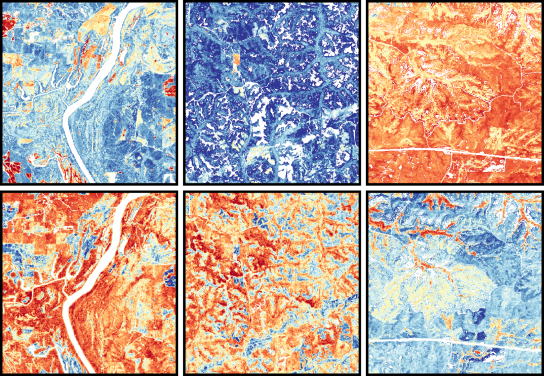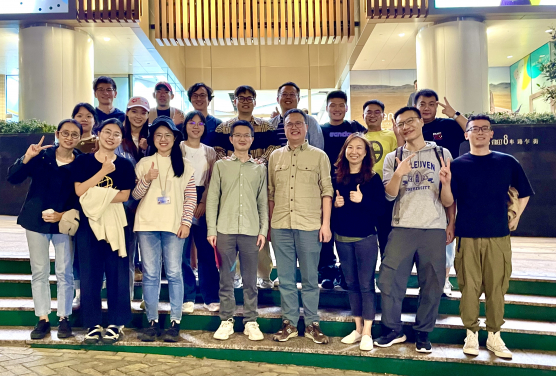Media
Mapping Plant Functional Diversity from Space: HKU Ecologists Revolutionise Ecosystem Monitoring with Novel Field-Satellite Integration
18 Apr 2024

High-resolution satellite images that captured multispectral data recorded the reflections of light from plant leaves. These data are not only of great research importance, providing valuable insights into the physical and biochemical properties of vegetation, but also showcase stunning patterns. Images adapted from Remote Sensing of Environment, 2024, doi.org/10.1016/j.rse.2024.114082.

Land cover (a) and functional trait maps produced from Satellite images. The team used four traits - LMA (b), nitrogen (c), potassium (d) and chlorophyll a+b (e) - as examples for demonstration. Figures adapted from Remote Sensing of Environment, 2024, doi.org/10.1016/j.rse.2024.114082.

High-resolution satellite images that captured multispectral data recorded the reflections of light from plant leaves. These data are not only of great research importance, providing valuable insights into the physical and biochemical properties of vegetation, but also showcase stunning patterns. Images adapted from Remote Sensing of Environment, 2024, doi.org/10.1016/j.rse.2024.114082.
- 1 / 3
- 2 / 3
- 3 / 3
An international team of researchers, led by Professor Jin WU from the School of Biological Sciences at The University of Hong Kong (HKU), has made a promising advancement in mapping plant functional traits from space using time-series satellite data. The study, published in Remote Sensing of Environment, showcases the innovative combination of the Sentinel-2 satellite mission and its dynamic time-series capabilities. This innovative approach not only unlocks a deeper understanding of essential foliar traits, providing crucial insights into the functional diversity and ecosystem functioning of terrestrial ecosystems, but it also equips us with powerful tools to address pressing environmental challenges effectively.
Leveraging the Satellites for In-depth Observations
Plant traits are vital in regulating key ecosystem processes such as carbon sequestration, air temperature regulation, and large-scale hydrological regulation. They also determine how ecosystems respond to various environmental stressors, ultimately determining their health, resilience, and vulnerability to climate change. However, large-scale mapping of these traits has been challenging due to limitations in existing methodologies, such as the difficulty in capturing traits across vast areas and issues such as data availability, trait complexity, and measurement techniques.
To overcome these challenges, Professor Wu’s team harnessed the power of satellite technology and introduced a pioneering approach that combines vegetation spectroscopy and phenology. Their approach utilised high-resolution imagery from the Sentinel-2 satellite, which captured multispectral data on a weekly interval with a 10-metre resolution. By analysing these satellite images, the team observed and recorded the reflections of light from plant leaves, providing valuable insights into the physical and biochemical properties of the vegetation. These observations were then compared to the timing of plant life cycle events, known as phenology. By integrating the data from satellite imagery and phenological observations, the team has been able to obtain comprehensive information about plant functional traits across high dimensions. This integration holds great potential for extending to other dimensions of plant characteristics, such as plant health, functioning, and resilience.
This method underwent thorough and rigorous testing to evaluate its efficacy, applicability across different scales, and potential for high-throughput monitoring. The test utilised benchmark data of 12 foliar traits collected from 14 geographically distant sites within the National Ecological Observatory Network (NEON) in the eastern United States.
Shuwen LIU, the first author and a PhD candidate from Professor Wu’s lab, stated: "Our approach effectively captures the diversity of plant traits at fine spatial scales while maintaining accuracy over large areas." Liu further explained that their method overcomes the limitations of other methods that rely solely on plant functional types or single image acquisitions.
The proposed approach outperformed traditional methods that rely on environmental variables or single Sentinel-2 images as predictors without requiring environmental variables to enhance predictive capabilities. This finding underscores the significance of phenological information in trait prediction and suggests that the ‘leaf economics spectrum’ theory may be the underlying mechanism driving their technical success. Given the model's proven effectiveness in 14 diverse ecosystem sites across the United States, it shows great promise for expansion to national and global scales, thereby enabling the monitoring of plant functional traits from ecosystem to regional and national levels.
Reflecting on the future potential of this research, Professor Wu said: "Future studies will focus on broader validation to fully exploit this technology’s potential in frontier basic science, such as understanding terrestrial ecosystems’ sensitivity response to climate change and identifying their respective tipping points. Additionally, there is great potential for applied science, particularly in exploring nature-based climate solutions."
About the research team
The Global Ecology and Remote Sensing (GEARS) lab at HKU aims to uncover the fundamental mechanisms that regulate vegetation-climate interactions across various scales, ranging from leaves to the global level. It employs a diverse range of tools, including cutting-edge geospatial techniques, field observations, eco-evolutionary and ecophysiological theories, earth system models, and high-performance computing. Its research goals are twofold: firstly, to advance fundamental science by exploring the mechanisms that link climate, species (functional) composition, and ecosystem processes, and secondly, to bridge the gap between scientific and technological advancements in order to address pressing environmental issues related to climate change, such as forest health monitoring, food security, climate change impact assessments, and nature-based climate change mitigation. About GEARS: https://wu-jin.weebly.com/
About Professor Jin Wu
Jin Wu is an Assistant Professor at HKU School of Biological Sciences and a recipient of the NSFC-Excellent Young Scholar (Hong Kong & Macau) award in 2019. Prior to this, he held a Goldhaber Distinguished Fellow position at Brookhaven National Laboratory and earned his PhD from the University of Arizona. With a wide range of interests in biodiversity, conservation, global change, and sustainability sciences, he utilises an integrated approach (combining remote sensing, AI, and domain knowledge) to study these topics and aims to enhance how people experience, understand, and appreciate our living habitats and inspire actions to sustain our natural ecosystems. He has published over 100 peer-reviewed papers, including in prestigious journals such as Science, Nature, Global Change Biology, and Remote Sensing of Environment. Currently, he serves as an Associate Editor for Remote Sensing in Ecology and Conservation.
Link to the paper and key figure:
The journal paper, entitled ‘Spectra-phenology integration for high-resolution, accurate, and scalable mapping of foliar functional traits using time-series Sentinel-2 data’, can be found at the following link: https://doi.org/10.1016/j.rse.2024.114082
For media enquiries, please contact Ms Casey To, External Relations Officer (tel: 3917 4948; email: caseyto@hku.hk / Ms Cindy Chan, Assistant Director of Communications of HKU Faculty of Science (tel: 3917 5286; email: cindycst@hku.hk).

